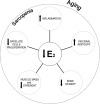Sarcopenia and Menopause: The Role of Estradiol
- PMID: 34093446
- PMCID: PMC8170301
- DOI: 10.3389/fendo.2021.682012
Sarcopenia and Menopause: The Role of Estradiol
Abstract
During aging and menopausal transition in women, a progressive muscle degeneration (i.e. decrease in quality and muscle function) occurs. This muscle dysfunction, caused by decreased proliferation of muscle satellite cells, increased levels of inflammatory markers, and altered levels of sex hormones, exposes women to a raised incidence of sarcopenia. In this regard, hormonal balance and, in particular, estradiol, seems to be essential in skeletal muscle function. The role of the estradiol on satellite cells and the release of inflammatory cytokines in menopausal women are reviewed. In particular, estradiol has a beneficial effect on the skeletal muscle by stimulating satellite cell proliferation. Skeletal muscle can respond to estrogenic hormonal control due to the presence of specific receptors for estradiol at the level of muscle fibers. Additionally, estradiol can limit inflammatory stress damage on skeletal muscle. In this review, we primarily focused on the role of estradiol in sarcopenia and on the possibility of using Estradiol Replacement Therapy, which combined with nutritional and physical activity programs, can counteract this condition representing a valid tool to treat sarcopenia in women.
Keywords: aging; endocrinology; hormones; menopause; muscle.
Copyright © 2021 Geraci, Calvani, Ferri, Marzetti, Arosio and Cesari.
Conflict of interest statement
The authors declare that the research was conducted in the absence of any commercial or financial relationships that could be construed as a potential conflict of interest. The reviewer BS declared a shared affiliation with some of the authors, RC and EM, to the handling editor at time of review.
Figures
References
Publication types
MeSH terms
Substances
LinkOut - more resources
Full Text Sources
Medical


